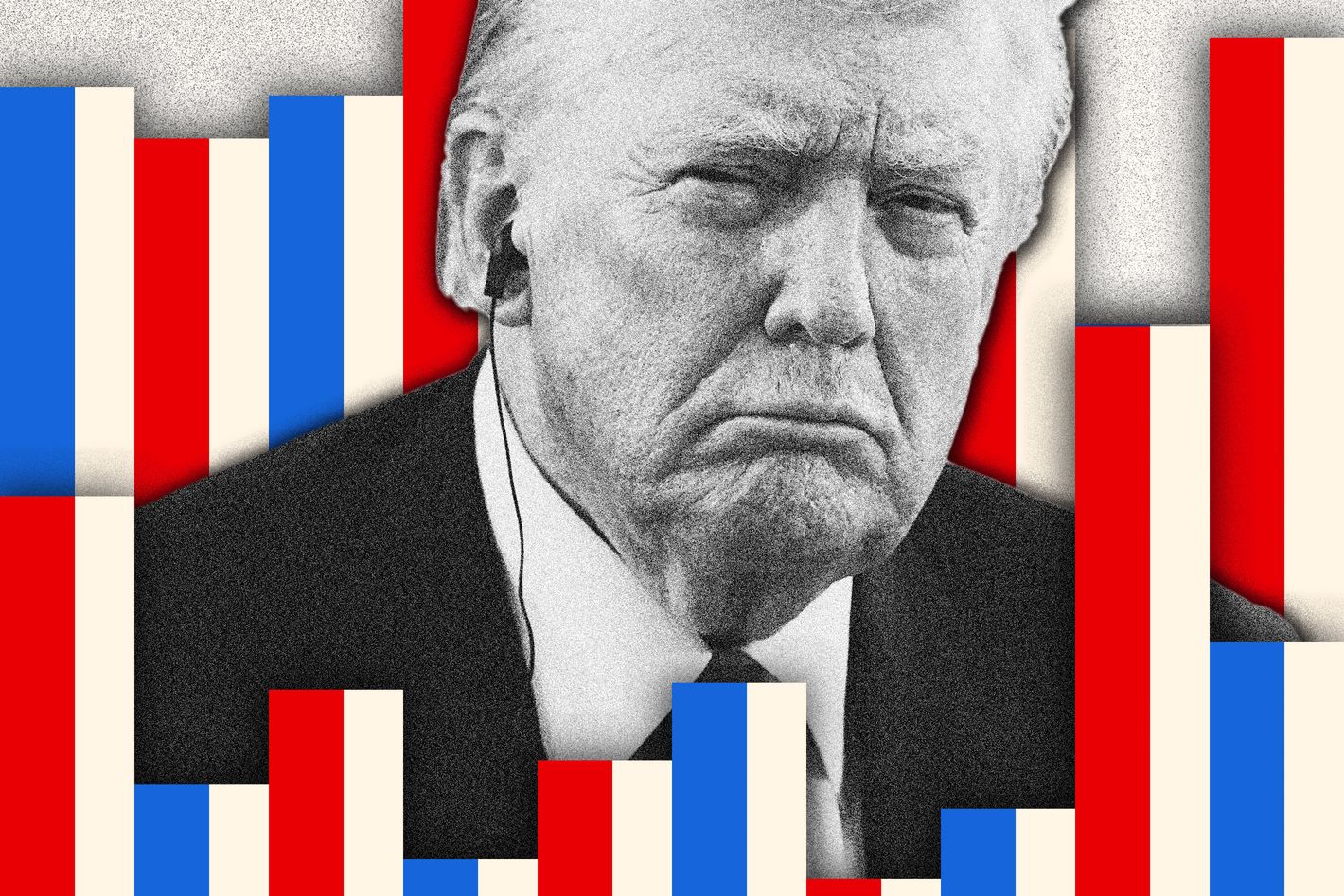
Photo-Illustration: Intelligencer; Photo: Getty Images
One of the major narratives that came out of the very poor showing of Republicans in the 2025 elections is that the GOP struggles to win when Donald Trump is not on the ballot. Certainly the president himself shares that belief, as he said on Election Night in no uncertain terms on social media: “‘TRUMP WASN’T ON THE BALLOT, AND SHUTDOWN, WERE THE TWO REASONS THAT REPUBLICANS LOST ELECTIONS TONIGHT.”
This was cold comfort for Republicans who understand that Trump isn’t going to be on the ballot in 2026 either. But beyond that, the narrative may not even be true. Polls keep showing that Trump is increasingly a drag on his party and that his weaknesses in the electorate very much resemble the GOP’s weaknesses on November 4.
There’s now little question that the president’s job-approval ratings have been steadily sliding downward for the past couple of months. On September 19, his net approval average at Silver Bulletin was at minus-7.5 percent (44.9 percent approval, 52.4 percent disapproval). On November 19, it was at minus-13.8 percent, which is a new low for his second term. The intensity of his unpopularity is high and rising: 45.3 percent of Americans strongly disapprove of the job Trump is doing as president, again per the averages at Silver Bulletin.
On particular issues, his net approval remains underwater on all the major categories: immigration (minus-7.1 percent), trade (minus-17), the economy (minus-20.2), and inflation (minus-34). The numbers for immigration, the economy, and inflation are at second-term lows. The last two are noteworthy given the importance of “affordability” in the 2025 Democratic victories (reflected in Trump’s own messaging beginning the moment the November 4 results were in) and, beyond that, the importance of these issues in Trump’s 2024 victory.
A poll from Fox News released on Wednesday probed more deeply into public sentiment on the economy and showed that the administration’s argument that high prices were caused by Joe Biden aren’t working anymore:
By a nearly 2-to-1 margin, voters say Trump is more responsible for the current economy than Biden (62% vs. 32%). Unsurprisingly, there’s a large partisan gap, as Democrats are nearly 40 percentage points more likely than Republicans to blame Trump. Somewhat surprisingly though, 42% of Republicans blame him, while a 53% majority says Biden is responsible. Among independents, 62% say Trump and 29% Biden.
Not all polls break down the electorate, but those that do are pretty consistent in showing that Trump’s 2024 coalition is shrinking back toward the hard-core MAGA base. New polling from The Argument reinforces that impression forcefully:
Republicans are hemorrhaging support with the young, nonwhite, and disengaged voters who powered Trump’s victory in 2024**.** Here are a few tidbits to show just what I’m talking about:
Democrats are winning 25% of nonwhite Trump 2024 voters. Among white voters, this number is just 4%.
Among registered voters who didn’t vote for either Harris or Trump in 2024, Democrats receive 62% of the vote — a 25-percentage-point lead. Among the white voters of this group, Democrats lead by two points; among nonwhite nonvoters, they lead by 48 points.
Democrats win 64% of young voters in our survey, for a lead of 28 points. (For context, in 2024, they won this group by just 10 points.)
Exit polls from the 2025 elections showed exactly the same pro-Democratic trends among young and nonwhite voters in New Jersey and Virginia. If the numbers persist into 2026, it’s hard to imagine Republicans hanging on to their control of the House — particularly if Trump’s effort to change the landscape through gerrymandering continues to flounder. In addition to Trump’s popularity issues, and despite their own well-known problems, Democrats are now opening up a significant lead in the congressional generic ballot, an approximation of the House popular vote next year. According to RealClear Polling, the average Democratic lead on the generic ballot is 4.8 percent, another 2025 high. The Argument explains what that might mean in the results:
If the election were held today, Republicans may be facing a blue wave larger than the 2018 midterms, which resulted in a commanding Democratic House majority. Put simply, they are in really bad shape.
How bad? Consider this: In our survey fielded right after the election, Nov. 10-17, Republicans trailed by four percentage points among registered voters. When we pushed undecided voters to pick a side, that deficit expanded to six percentage points. And after that was filtered to just those who said they were likely to vote, it grew even further, to 7.6 points.
So neither the GOP nor its leader are doing that well at the moment, particularly on the affordability issues that they now recognize are so crucial to swing voters. Some Republican candidates in 2026 will choose to cleave to Trump even more fiercely, and others may try to achieve some distance, but they’re probably joined at the hip for better or worse.
From Intelligencer - Daily News, Politics, Business, and Tech via this RSS feed

